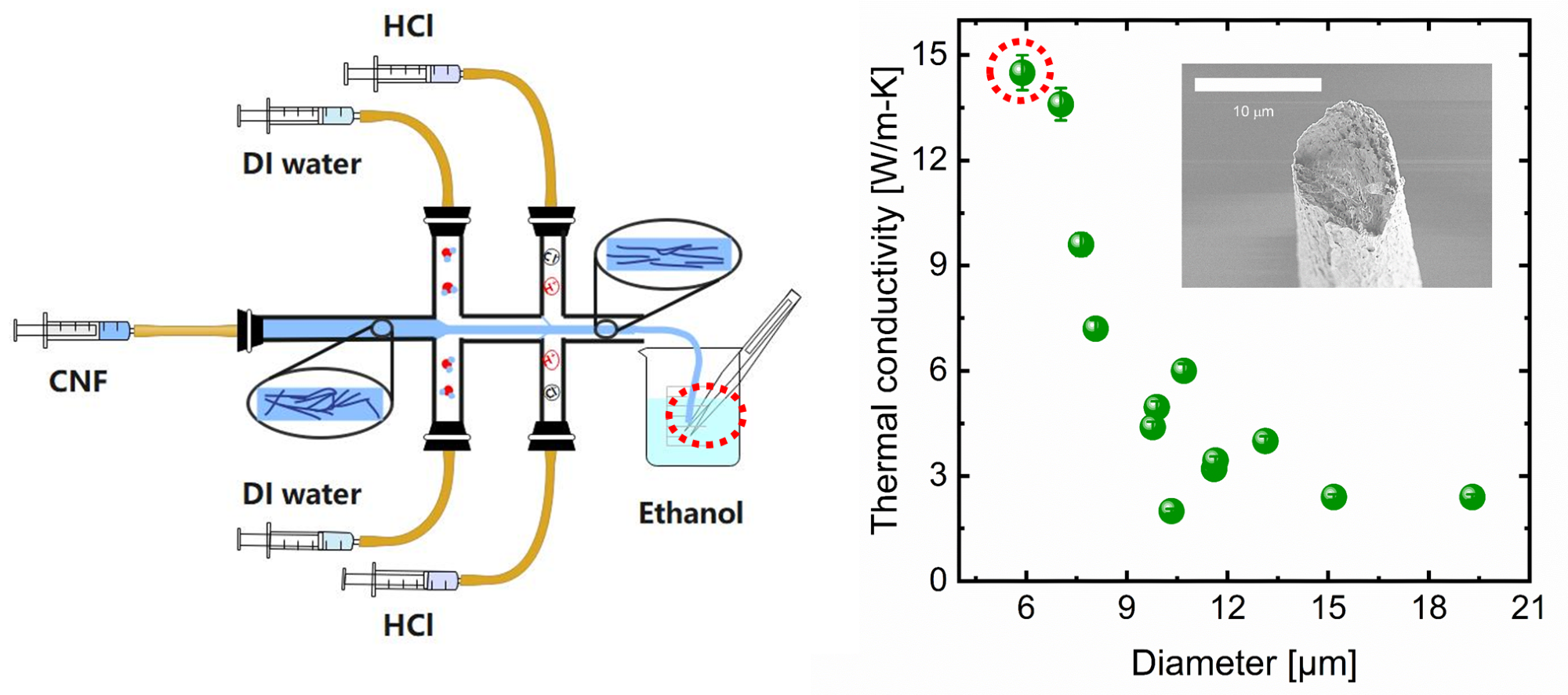Reviewed by Emily Henderson, B.Sc.Nov 7 2022
On a frequent basis, thermally insulating properties have been exhibited by plant-derived materials like cellulose. A new material created from nanoscale cellulose fibers displays reverse and high thermal conductivity. This makes it beneficial in regions that are dominated earlier by synthetic polymer materials.
 Flow focusing and CNF. The apparatus to create thermally conducting CNF using disorganized CNF, water, and hydrochloric acid (left). A graph shows how the sample's thermal conductivity changes with its diameter. (right). Image Credit: ©2022 Shiomi et al.
Flow focusing and CNF. The apparatus to create thermally conducting CNF using disorganized CNF, water, and hydrochloric acid (left). A graph shows how the sample's thermal conductivity changes with its diameter. (right). Image Credit: ©2022 Shiomi et al.
Materials based on cellulose exhibit environmental advantages over polymers, so a study on this could result in greener technological applications where thermal conductivity is required.
Cellulose is known as a main structural component of plant cell walls and is the cause of why trees have the potential to grow to such heights. However, the mystery of its material strength comes from its overlapping nanoscopic fibers.
Several commercial products have utilized cellulose nanofiber (CNF) materials in the past few years due to their durability and strength. This makes them a good substitute for polymer-based materials like plastics that could be harmful to the surrounding.
However, currently and for the first time, a study group headed by Professor Junichiro Shiomi from the University of Tokyo’s Graduate School of Engineering has examined earlier unidentified thermal properties of CNF, and their outcomes display that such materials could be even more beneficial now.
If you see plant-derived materials such as cellulose or woody biomass used in applications, it’s typically mechanical or thermally insulating properties that are being employed. When we explored the thermal properties of a yarn made from CNF, however, we found that they show a different kind of thermal behavior, thermal conduction, and it’s very significant, around 100 times higher than that of typical woody biomass or cellulose paper.
Junichiro Shiomi, Professor, Graduate School of Engineering, University of Tokyo
The cause yarn was made from CNF and had the potential to conduct heat so well because of the way it is being made. Cellulose fibers in nature are very disordered. However, a process known as the flow-focusing method integrates cellulose fibers, thereby orientating them in a similar method to make CNF.
This closely bound and aligned pack of rod-shaped fibers enables heat to transfer along the bundle. Here, a more chaotic structure would disperse heat more readily.
Our main challenge was how to measure the thermal conductivity of such small physical samples and with great accuracy. For this, we turned to a technique called T-type thermal conductivity measurement.
Junichiro Shiomi, Professor, Graduate School of Engineering, University of Tokyo
“It allowed us to measure the thermal conductivity of the rod-shaped CNF yarn samples, which are only micrometers (a micrometer equaling one-thousandth of a millimeter) in diameter. But the next step for us is to perform accurate thermal tests on two-dimensional textilelike samples.”
Shiomi and his team believe that their investigation and forthcoming explorations into CNF as a thermally conductive material could provide engineers with an alternative to a few environmentally detrimental polymers.
In applications where heat transfer is significant, like few computational or electronic components, it could considerably decrease the impacts of rejected electronic equipment, or e-waste, as a result of the biodegradable nature of CNF and other plant-based materials.
Journal Reference:
Wang, G., et al. (2022) Enhanced High Thermal Conductivity Cellulose Filaments via Hydrodynamic Focusing. Nano Letters. doi.org/10.1021/acs.nanolett.2c02057.